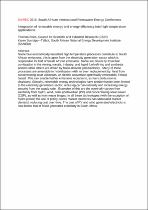 ResearchSpace
ResearchSpace
Integration of renewable energy and energy efficiency into high temperature applications
JavaScript is disabled for your browser. Some features of this site may not work without it.
- ResearchSpace
- →
- Research Publications/Outputs
- →
- Conference Publications
- →
- View Item
| dc.contributor.author |
Roos, T

|
|
| dc.contributor.author |
Surridge-Talbot, K

|
|
| dc.date.accessioned | 2016-10-13T13:47:53Z | |
| dc.date.available | 2016-10-13T13:47:53Z | |
| dc.date.issued | 2015-10 | |
| dc.identifier.citation | Roos, T. and Surridge-Talbot, K. 2015. Integration of renewable energy and energy efficiency into high temperature applications. In: SAIREC 2015, South African International Renewable Energy Conference, Cape Town, 4 to 7 October 2015 | en_US |
| dc.identifier.uri | http://www.sairec.org.za/wp-content/uploads/2015/08/Issue-Paper_High-Temperature-Applications.pdf | |
| dc.identifier.uri | http://hdl.handle.net/10204/8834 | |
| dc.description | SAIREC 2015, South African International Renewable Energy Conference, Cape Town, 4 to 7 October 2015. Due to copyright restrictions, the attached PDF file only contains the abstract of the full text item. | en_US |
| dc.description.abstract | Numerous economically important high temperature processes contribute to South African emissions; this is apart from the electricity generation sector which is responsible for half of South African emissions. Some are driven by fossil fuel combustion in the mining, metals, industry, and liquid fuel refining and synthesis sectors while others are driven by fossil-derived grid electricity. Many of these processes are amenable to hybridisation with, or even replacement by, heat from concentrating solar collectors, or electric conversion (preferably renewable) if fossil-based. This can enable further emissions reductions, as fuel combustion is displaced. Globally, renewable energy technologies have predominantly been limited to the electricity generation sector, reducing carbon intensity and increasing energy security from the supply side. Examples of this are the nominally carbon-free electricity from hydro, wind, solar photovoltaic (PV) and concentrating solar power (CSP), as well as from waste biogas. In all these technologies (with the exception of hydro power) the use of policy-driven market incentives has stimulated market demand, reducing cost over time. The cost of PV and wind generated electricity is now below that of fossil-generated electricity in South Africa. | en_US |
| dc.language.iso | en | en_US |
| dc.relation.ispartofseries | Worklist;16031 | |
| dc.subject | Renewable energy | en_US |
| dc.subject | South African emissions | en_US |
| dc.subject | Concentrating solar power | en_US |
| dc.subject | CSP | en_US |
| dc.subject | Photovoltaic | en_US |
| dc.subject | PV | en_US |
| dc.title | Integration of renewable energy and energy efficiency into high temperature applications | en_US |
| dc.type | Conference Presentation | en_US |
| dc.identifier.apacitation | Roos, T., & Surridge-Talbot, K. (2015). Integration of renewable energy and energy efficiency into high temperature applications. http://hdl.handle.net/10204/8834 | en_ZA |
| dc.identifier.chicagocitation | Roos, T, and K Surridge-Talbot. "Integration of renewable energy and energy efficiency into high temperature applications." (2015): http://hdl.handle.net/10204/8834 | en_ZA |
| dc.identifier.vancouvercitation | Roos T, Surridge-Talbot K, Integration of renewable energy and energy efficiency into high temperature applications; 2015. http://hdl.handle.net/10204/8834 . | en_ZA |
| dc.identifier.ris | TY - Conference Presentation AU - Roos, T AU - Surridge-Talbot, K AB - Numerous economically important high temperature processes contribute to South African emissions; this is apart from the electricity generation sector which is responsible for half of South African emissions. Some are driven by fossil fuel combustion in the mining, metals, industry, and liquid fuel refining and synthesis sectors while others are driven by fossil-derived grid electricity. Many of these processes are amenable to hybridisation with, or even replacement by, heat from concentrating solar collectors, or electric conversion (preferably renewable) if fossil-based. This can enable further emissions reductions, as fuel combustion is displaced. Globally, renewable energy technologies have predominantly been limited to the electricity generation sector, reducing carbon intensity and increasing energy security from the supply side. Examples of this are the nominally carbon-free electricity from hydro, wind, solar photovoltaic (PV) and concentrating solar power (CSP), as well as from waste biogas. In all these technologies (with the exception of hydro power) the use of policy-driven market incentives has stimulated market demand, reducing cost over time. The cost of PV and wind generated electricity is now below that of fossil-generated electricity in South Africa. DA - 2015-10 DB - ResearchSpace DP - CSIR KW - Renewable energy KW - South African emissions KW - Concentrating solar power KW - CSP KW - Photovoltaic KW - PV LK - https://researchspace.csir.co.za PY - 2015 T1 - Integration of renewable energy and energy efficiency into high temperature applications TI - Integration of renewable energy and energy efficiency into high temperature applications UR - http://hdl.handle.net/10204/8834 ER - | en_ZA |





